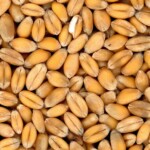
Executive Summary
Using a Prize Competition to Encourage Scale-up of AflasafeTM in Nigeria
The AgResults Nigeria AflasafeTM Challenge Project, which ran from 2013 to 2019, used a Pay-for Results (PfR) prize competition to motivate the private sector to overcome critical barriers preventing widespread adoption of AflasafeTM among Nigerian smallholder farmers working in the maize sector. By providing an incentive, the project successfully catalyzed private sector actors in Nigeria’s maize value chain to test and deliver AflasafeTM to farmers. As more farmers learned how to correctly apply this biocontrol agent, they produced higher-quality maize with reduced levels of aflatoxins that met international standards for export. By tying a monetary prize to a healthier and safer product, the project increased awareness of aflatoxins and built market linkages that created a premium market.
 The project’s Theory of Change (ToC) thought that by leveraging AflasafeTM, the project would engage private sector maize aggregators and encourage them to raise awareness and adoption of AflasafeTM as an effective solution to producing aflatoxin-reduced maize. It was assumed that increased awareness would drive demand among smallholder farmers and value chain actors, improve health, increase maize quality, increase aflatoxin-reduced maize level consumption, and stimulate a premium market to improve smallholder farmer incomes and produce sustainability.The project engaged the private sector by countering the risks of investment in aflatoxin-reduced maize through temporarily offsetting constraints with guaranteed incentives for successful aggregation. Each competitor was awarded US $18.75 for each metric ton (MT) of aflatoxin-reduced maize they procured from smallholder farmers that passed required AflasafeTM detection tests, conducted and paid for by AgResults. Test samples were taken at aggregation points prior to selling.
The project’s Theory of Change (ToC) thought that by leveraging AflasafeTM, the project would engage private sector maize aggregators and encourage them to raise awareness and adoption of AflasafeTM as an effective solution to producing aflatoxin-reduced maize. It was assumed that increased awareness would drive demand among smallholder farmers and value chain actors, improve health, increase maize quality, increase aflatoxin-reduced maize level consumption, and stimulate a premium market to improve smallholder farmer incomes and produce sustainability.The project engaged the private sector by countering the risks of investment in aflatoxin-reduced maize through temporarily offsetting constraints with guaranteed incentives for successful aggregation. Each competitor was awarded US $18.75 for each metric ton (MT) of aflatoxin-reduced maize they procured from smallholder farmers that passed required AflasafeTM detection tests, conducted and paid for by AgResults. Test samples were taken at aggregation points prior to selling.
Uptake by farmers was slow in the first two years. Raising awareness of the problem and solution presented a challenge for AgResults. Smallholder farmers and maize aggregators had to be convinced that AflasafeTM worked and was worth the extra effort and cost. There were also financial constraints: The aggregators purchased AflasafeTM upfront on behalf of their farmers and usually had to wait several weeks after the harvest to get paid, making access to finance a critical step. Often the aggregators also needed to obtain financing for maize purchases — a large financial commitment in a business with traditionally low margins.
After an initial familiarization and testing process by smallholder farmers during the first year, adoption increased and steadily continued to rise in the subsequent years. In the last year, the incentive was reduced by 50% to test the sensitivity of the market and even with the reduction, aflatoxin-reduced maize volumes reached exceptional heights.

The prize incentives stimulated the growth of an early premium market as smallholder farmers provided the aflatoxin-reduced maize to processors for human, poultry, and swine consumption. There was also an increase in smallholder awareness of the dangers of aflatoxins and benefits of using AflasafeTM.
Over six years, the project exceeded its primary objectives and laid the foundation for a sustainable market for high-quality maize accessible by Nigeria’s smallholder farmers. By emphasizing the proper application of AflasafeTM through training, the competition encouraged a diverse set of actors along the maize value chain to rethink their relationships with farmers in ways that benefited all groups. As the AgResults project was wrapping up in 2019, it was clear that through the prize competition—and complementary efforts such as the ATTC project and the government’s subsidy loan program—the availability and use of AflasafeTM had dramatically increased, setting up a potential future of lasting health and economic benefits for smallholder farmers (see the project final report and final evaluation report for more details).
AgResults had not been working in isolation. Before looking at what happened in the last four years, it is key to recognize the role of two related entities during the life of the project: The International Institute of Tropical Agriculture (IITA) and Harvestfield Industries Limited (HIL).
AflasafeTM in the Laboratory: The Early Role of IITA

Aflatoxin contamination is a global problem, and biocontrol has long been the most promising solution. Biocontrol involves introducing natural, native strains of Aspergillus that do not produce aflatoxins to naturally out-compete aflatoxinproducing strains. By doing so, they greatly reduce the potential for aflatoxin contamination. Unlike other interventions, such as clay binders and postharvest management, biocontrol works in the field to reduce the population of aflatoxin-producing fungi in the first instance, preventing aflatoxin contamination throughout the value chain from field to final consumer.
Since 1967, the International Institute of Tropical Agriculture (IITA) has led the push for a wide variety of agricultural solutions across sub-Saharan Africa. IITA focuses on research and development, collaborating with international and national partners to improve livelihoods, enhance food and nutrition security, and increase employment. The Nigerian product, AflasafeTM, was the pioneer of a collection of AflasafeTM products for Africa, customized for each country. IITA developed it for Nigeria in the early 2000s in collaboration with the United States Department of Agriculture – Agricultural Research Service, University of Bonn (Germany), and University of Ibadan. Field trials were performed for the next several years to gauge how effective, safe, and suitable the biocontrol product was for use in Nigeria.
AflasafeTM was a product of IITA’s Business Incubation Platform (BIP), and as such, IITA was dedicated to shifting AflasafeTM technical know-how and production to the private sector to spark broader market access. The AflasafeTM Technology Transfer and Commercialization (ATTC) initiative did just that.
AflasafeTM Goes Commercial: Transfer of Production from IITA To Harvestfield
In late 2015, USAID and the Bill and Melinda Gates Foundation funded the AflasafeTM Technology Transfer and Commercialization (ATTC) project to facilitate the responsible transfer of AflasafeTM from IITA, a research institution, to private sector manufacturers and distributors that were better positioned to increase the scale of AflasafeTM production and distribution. ATTC aimed to scale AflasafeTM production and distribution in 11 additional countries in Africa, including Nigeria. As demand for AflasafeTM increased, IITA and ATTC identified Harvestfield Industries Limited (HIL), a private sector input provider, to take over production, distribution, and sales in Nigeria.
The technology transfer from IITA to HIL began in 2016 and continued through 2019. The agreement focused on more than just sales: The Technology Transfer and Licensing Agreement (TTLA) set annual targets and required that HIL effectively distribute AflasafeTM to farmers. HIL built on IITA’s early sensitization and demonstration efforts, training more than 13,500 farmers across Nigeria. The company also engaged local governments and led roundtables that emphasized export opportunities for high-quality maize.
During this time, IITA raised competitor awareness of ATTC and informed them that AflasafeTM production and distribution was transferring from IITA to HIL. In the competition’s final year, IITA transferred all AflasafeTM sales to HIL and worked with HIL to build a large manufacturing facility near Lagos. At the end of the competition, HIL was stocking AflasafeTM at outlets across the country, and 14 competitors had placed AflasafeTM orders for the 2019-2020 planting season.
HIL committed to educating farmers, millers, farm-produce aggregators, exporters, and food processors on the dangers of aflatoxins, the benefits of AflasafeTM, and effective ways to use the technology. The company undertook a national aflatoxin awareness campaign, targeting 54 communities across 28 states.
Everything was poised for HIL to become a distributor to Nigeria and neighboring countries in the region. However, the years that followed the end of the AgResults project proved to be more challenging than anticipated, painting a very different picture of AflasafeTM’s future.
Revisiting Assumptions from the AgResults Project
Four years after the AgResults project in Nigeria ended, the public sector and private sector landscape for AflasafeTM looks disappointingly different: Business investment in AflasafeTM production and distribution has stagnated, and the government has not demonstrated any sustained effort to enact policy around maize quality. To fully understand how this seemingly abrupt shift occurred, it is necessary to revisit four related assumptions that the AgResults project had when designing and implementing the prize competition:

Assumption 1: A Pay-for-Results prize competition can drive the adoption of an effective technology.
Assumption 2: Due to an observable economic benefit, AflasafeTM use will continue after the project ends.


Assumption 3: Based on the economic benefit of AflasafeTM and heightened awareness around aflatoxins, a premium market will develop around AflasafeTM-treated maize.
Case Study: Babban Gona

Food Insecurity and Lackluster Market Demand
Another important influence that tamped down market interest in AflasafeTM-treated maize was high levels of food insecurity. Nigeria is a food-deficit country with high levels of undernourishment and food vulnerability. The COVID-19 pandemic spurred geopolitical and economic crises in 2020, causing widespread food insecurity. From this, the Food and Agriculture Organization (FAO) and other observers of food commodity markets issued warnings illustrating concern for the collapse of food supply related to commodity crops such as maize.
The subsequent maize shortage caused a dramatic change in consumer behavior around maize consumption: Although the AgResults prize competition had been helping to drive higher awareness around aflatoxin contamination and spark interest in higher-quality maize, famine led to a sharp U-turn. Faced with widespread hunger, the threat of aflatoxin contamination suddenly seemed mild in comparison. Interest in and demand for differentiated maize quality fell, and as such, there was little to sustain and expand the premium maize market. At the same time, national government priorities shifted toward addressing the health and economic impacts of COVID and enacting short-term responses. As such, policies that focused on crop quality became secondary to policies that simply encouraged increases in the amount of maize circulating in Nigerian markets. These shifts have since become the norm.
Looking at the broader landscape in Nigeria, today there is only a niche secondary market of AflasafeTMtreated products, mainly from sectors that are being exported — such as peanuts and dried ginger — and must meet international aflatoxin standards. When combined with the fourth assumption described below, it becomes understandable why AflasafeTM adoption has steadily declined in the last few years.
Assumption 4: With greater consumer awareness, higher production of aflatoxinreduced maize, and more market opportunities for AflasafeTM, government standards and policy enforcement around maize quality will develop.
A fourth assumption focused on policy: The AgResults project assumed that, upon seeing the potential market for AflasafeTM-treated maize, the Nigerian government would create policy to define and enforce standards for maize quality. Specifically, seeing the growth of consumer awareness and market demand for maize that was not contaminated by aflatoxins, the National Agency for Food and Drug Administration and Control (NAFDAC) would create regulation and enforcement tools for AflasafeTM-treated maize during the project. Such regulation would lay the foundation for continued standards around differentiated maize after the competition ended, building on growing demand and creating a virtuous cycle of improvement.
The AgResults project had always envisioned that the Government of Nigeria would play this role: Once the project generated sufficient volume of aflatoxin-reduced maize and raised awareness of its benefits, the government would lead three activities to further this cause: 1) promote awareness of the benefits of AflasafeTM; 2) establish policy reforms to encourage its widespread use; and 3) implement programs to establish maize quality standards and monitor their compliance.
Such policy never materialized. NAFDAC has not fulfilled expectations regarding promotion, awareness raising, or technical capacity building. Furthermore, the government has not enforced value chain actors to supply and distribute aflatoxin-reduced maize. The legislation to potentially combat this, Food Safety and Quality Bill 2019 (HB.19.01.1598), has still not passed Parliament.
Without any standards or enforcement from the government, there has been no real guarantee of quality, leading to responsibility being haphazardly segmented further down the value chain. Combined with the limited market demand for aflatoxin-reduced maize, this creates strong economic disincentive for aggregators or other commercial processors of maize because it falls on them to put in the time and effort to test maize quality without any concrete benefit.

Nigeria is not alone; in fact, despite systematic support to develop and distribute AflasafeTM across the region, no governments have changed their approach to regulation or enforcement. As a result, no sustainable market for AflasafeTM has developed.
It’s also important to revisit the food insecurity and maize shortage discussed in the previous section from a policy standpoint. In addition to creating meager market demand for AflasafeTM-treated maize, famine meant that the government had no incentive to restrict the supply of maize in the country’s markets: As the AgResults competition was ending in 2019, demand for aflatoxin-reduced maize was growing; in contrast, a few years later, the demand was simply for any maize, no matter the aflatoxin levels. The government was focused on filling demand and feeding as many people as possible, so there was no incentive to start removing any maize from the supply — even based on aflatoxin contamination levels.
This has revealed a larger lesson from the AgResults competition in Nigeria, one that has also surfaced in other competitions that tried to target scale-up around commodities: Commodity prices are subject to government control and thus can be highly volatile. Consequently, a technology targeting a commodity may also experience drastic swings in use, price, and adoption. In the case of AflasafeTM, a technology that was effective and available, complications in the commodity’s enabling environment led to complications in AflasafeTM’s adoption and market growth.
Balancing Technology with Policy: A Programmatic Lesson
The critical role of the enabling environment in driving — or deterring — adoption of a technology highlights a programmatic lesson for development donors. When funding or designing a program that is trying to address technology adoption or scale-up, it is crucial to analyze and plan for the given enabling environment.
This is doubly true when a program aims to target a commodity. As the previous section illustrated, commodity prices are subject to government control and can be highly volatile because of the government’s tight grip on that staple. From a programmatic standpoint, donors must factor this into program design decisions. Sometimes this means considering opportunities for policy interventions alongside technology interventions, and other times this simply means acknowledging that the project may end up with limited influence because it is targeting a commodity.
In the case of Pay-for-Results prize competition design, since the idea of incentives is at the heart of the program, it might ultimately be best not to target a commodity because they are so sensitive to government policies. How involved or hands-off the government is can make a huge difference in the way that the private sector gets involved and, from there, how the market develops.
Conclusion
From 2013-2019, the AgResults Nigeria AflasafeTM Challenge Project used a Pay-for-Results prize competition to motivate private sector grain aggregators to work with smallholder farmers to adopt AflasafeTM and to produce aflatoxin-reduced maize. The project succeeded in emphasizing the proper application of AflasafeTM through training and encouraging a diverse set of actors along the maize value chain to rethink their relationships with farmers in ways that benefited all groups. Yet, the four years following the prize competition have highlighted an important lesson in the influences surrounding the adoption and scaleup of a technology. Despite its proven effectiveness and continued improvement, widespread use of the biocontrol solution AflasafeTM has stagnated in the country and broader region.
Although AgResults and IITA could be seen as early catalysts for the promotion and adoption of AflasafeTM, without a sustained economic benefit, there was not enough incentive for its continued use and not enough demand for the development of a long-term premium market around aflatoxin-reduced maize. Subsequently, there was little government investment in creating and enforcing standards around maize quality. Without these appropriate regulations and enforcement of safety, a sustainable market with scale has not developed. Some market still exists, but not with the volume to produce sustainable benefits.
Beyond these economic and market systems lessons, a post-project reflection on AflasafeTM use in Nigeria has highlighted a programmatic lesson for development donors: When funding programs that address technology adoption, particularly those that involve commodities, donors need to consider the broader enabling environment. Policy and government involvement must be targeted along with the technology itself, or the ultimate impact may be limited.
About AgResults


For more information, check out the Learning Library on the AgResults website: http://www.agresults.org/learning



